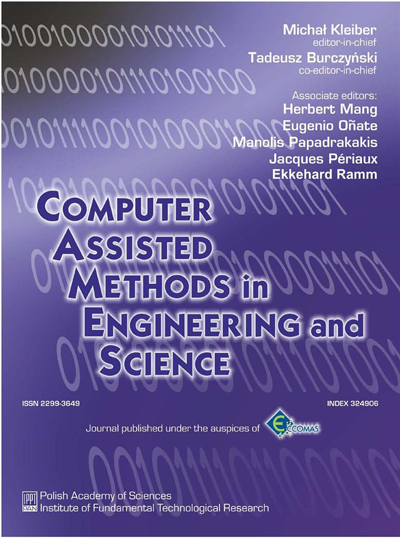Applying Artificial Neural Networks for analysis of geotechnical problems
Abstract
The paper presents a discussion of some applications of Artificial Neural Networks (ANNs) in geoengineering using the analysis of the following six geotechnical problems, related mainly to prediction and classification purposes: 1) prediction of Overconsolidation Ratio (OCR), 2) determination of potential soil liquefaction, 3) prediction of foundation settlement, 4) evaluation of piles bearing capacity, 5) prediction of compaction parameters for cohesive soils, 6) compaction control of embankments built of cohesionless soils. The problems presented are based on the applications of the Multi-Layered Perceptron (MLP) neural networks.
Keywords
geotechnical problems, artificial neural networks (ANNs), Multi-Layer Perceptron (MLP), Overconsolidation Ratio (OCR), bearing capacity of piles, settlement of foundation, soil liquefaction, compaction control,References
[1] J.B. Burland. Shaft friction of piles in clay – A simple fundamental approach. Ground Engineering, 6: 1–15, 1973.[2] B.S.-Y. Chen, P.W. Mayne. Profiling the OCR of Clays by Piezocone Tests. Report No. CEEGEO-94-1, Georgia Institute of Technology, Atlanta, 1994.
[3] A.T.C. Goh. Empirical design in geotechnics using Neural Networks. Géotechnique, 45: 709–714, 1995.
[4] A.T.C Goh. A back propagation approach for predicting seismic liquefaction potential in soils. In: Neural Networks, IEEE World Congress on Computational Intelligence, 5: 3322–3325, Orlando, USA 1994.
[5] K. Kądziołka, Z. Waszczyszyn, M.J. Sulewska. Determination of dynamic deformation modulus for non-cohesive soils by Artificial Neural Networks [in Polish]. In: Proc. the 48-th Conf. of Polish Academy of Science, 3: 249–256, Krynica 2002.
[6] P.U. Kurup, N.K. Dudani. Neural Networks for profiling stress history of clays from PCPT data. Journal of Geotechnical and Geoenvironmental Engineering, 128: 569–579, 2002.
[7] P.W. Mayne. Determination of OCR in clays by PCPT using cavity expansion and critical state concepts. Soils Foundations, 31: 65–76, 1991.
[8] G.G. Meyerhof. Shallow foundations. Journal of the Soil Mechanics and Foundation Division, 91(SM2): 21–31, 1965.
[9] Y.M. Najjar, I.A. Basheer, W.A. Naouss. On the identification of compaction characteristics by Neuronets. Computers and Geotechnics, 18: 167–187, 1996.
[10] J.H. Schmertmann, J.P. Hartman, P.B. Brown. Improved strain influence factor diagrams. Journal of Geotechnical Engineering, 104: 1131–1135, 1978.
[11] E. Schultze, G. Sherif. Prediction of settlements from evaluated settlement observations for sand. In: Proc. of the 8-th International Conference Soil Mechanics and Foundation Engineering, 1: 225–230, Moscow, 1973.
[12] R.M. Semple, W.J. Ridgen. Shaft capacity of driven pipe piles in clay. Ground Engineering, 19: 11–17, 1986.
[13] M.A. Shahin, H.R. Maier, M.B. Jaksa. Predicting settlement of shallow foundations using Neural Networks. Journal of Geotechnical and Geoenvironmental Engineering, 128: 110–120, 2002.
[14] M.J. Sulewska. Artificial neural networks in the evaluation of non-cohesive soil compaction parameters [in Polish]. Committee Civil Engineering of the Polish Academy of Sciences, Warsaw-Bialystok, 2009.
[15] M.J. Sulewska. Modulus of deformation for non-cohesive soil determined applying dynamic method [in Polish]. PhD Research, Faculty of Civil and Environmental Engineering, Bialystok University of Technology, 1993.
[16] J.P. Sully, R.G. Campanella, P.K. Robertson. Overconsolidation ratio of clays from penetration pore pressures. Journal of Geotechnical Engineering Division, 114: 209–216, 1988.
[17] M.T. Tumay, P.U. Kurup, G.Z. Voyiadjis. Profiling OCR and Ko from piezocone penetration tests. In: Proc. of the International Symposium on Cone Penetration Testing, 2: 337–342, Swedish Geotechnical Society, SGF Report No. 3, Linkoping, Sweden, 1995.
[18] S. Haykin. Neural Networks – Comprehensible Foundations, 2nd edition. Upper Saddle River, NJ: Prentice-Hall, 1999.
[19] M. Kłos, M.J. Sulewska, Z. Waszczyszyn. Neural identification of compaction characteristics for granular soils, Computer Assisted Mech. Eng. Sci., 18(4): 265–273, 2011.
Published
Jan 25, 2017
How to Cite
SULEWSKA, Maria J..
Applying Artificial Neural Networks for analysis of geotechnical problems.
Computer Assisted Methods in Engineering and Science, [S.l.], v. 18, n. 4, p. 231–241, jan. 2017.
ISSN 2956-5839.
Available at: <https://cames.ippt.gov.pl/index.php/cames/article/view/101>. Date accessed: 31 may 2025.
Issue
Section
Articles




